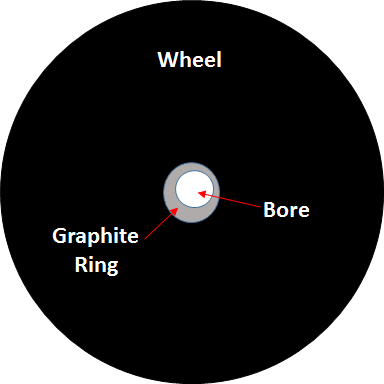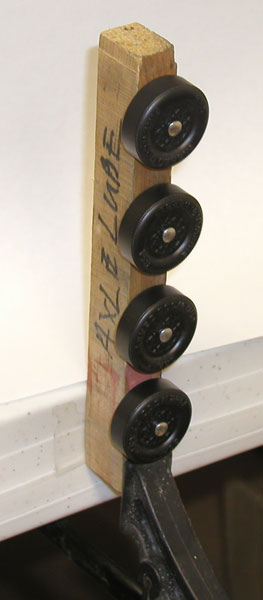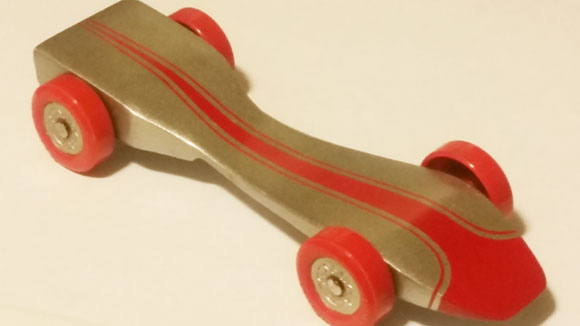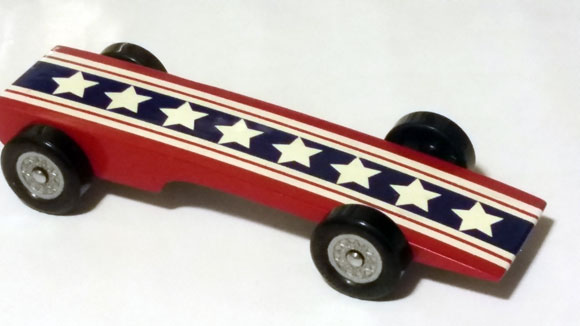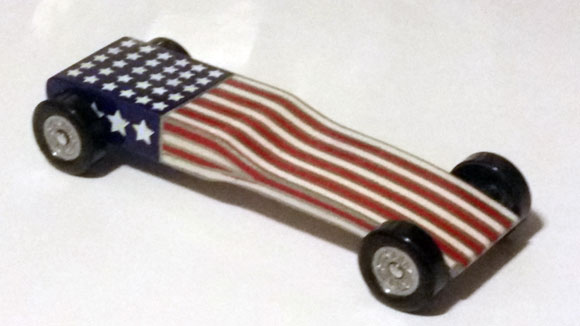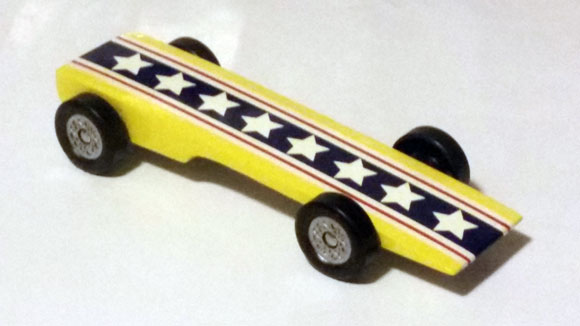– Feature Article – Graphite Questions (Most Popular Questions)
– Humor
– Pinewood Derby Car Showcase
– Q&A
Feature Article
Graphite Questions: The Two Most Popular Questions of the 2013-14 Season
By Randy Davis
Each pinewood derby season, there are always a few questions that get asked more than any others. Some years the questions are about weighting, while other years the questions are about alignment. But during the past season, there were two popular questions about lubricating with graphite. So let’s discuss these in detail.
Question 1: How do you get graphite to stick to the axles?
The short answer is, “You don’t want graphite to stick to the axles”, but let’s go a little deeper. Graphite is carbon in a unique molecular structure; the carbon atoms are formed into a layered structure. These layers allow the molecules to slide on each other, thus giving dry powered graphite a natural lubrication ability.
Dry graphite does not typically stick to metal or any non-porous surface. So, it does not stick to pinewood derby axles. However, it does stick to porous surfaces, specifically polystyrene, which is the plastic from which most pinewood derby wheels are made.
So, when lubricating pinewood derby wheels and axles, the graphite adheres to the inner bore of the wheel, and the axle slides on the graphite (and the graphite slides on itself). If the layer of graphite on the bore is sufficiently thick, then all contact between the metal axle and the plastic wheel is eliminated, resulting in a significant reduction in friction. Building this layer of graphite can be done in many ways, but all involve repeatedly adding graphite and rotating the wheel on the axle.
There is a way to make graphite stick to an axle. This involves making a graphite paste by adding isopropyl alcohol. The axle is then dipped in the mixture and allowed to dry. Unfortunately, the resulting coating does not lubricate as well as dry graphite because the molecular structure is modified in the process. For this reason, Maximum Velocity does not offer graphite-coated axles. In all of our performance tests, graphite-coated axles were inferior to polished axles.
Question 2: What do you think of that graphite packing video on YouTube?
There are a lot of videos about graphite packing. These can be divided into two categories: wet packing and dry packing.
Wet Packing
Wet-packing involves making a graphite paste as described above. The axle is inserted into the wheel and the paste is pressed into the bore around the axle. After the graphite dries, the axle can be removed leaving a thick ring of hard graphite on the bore of the wheel.
There are two significant issues with this process:
- There is no guarantee that the graphite ring is concentric with the bore of the wheel. In fact, it would take precision equipment to make a truly concentric ring (see Figure 1).
Figure 1 – Non-concentric Graphite Ring
In one video, after the ring is created the producer of the video spins the wheel on the axle. He states: “This wheel isn’t balanced at all; you can see how it wobbles.” Almost certainly, the real problem is not the wheel; the wobble is because the graphite ring is not concentric. - The ring does not lubricate as well as dry graphite. As described previously, in our testing, graphite with alcohol was always slower than dry graphite. In fact, if you watch the video mentioned above you will note that there is no comparison test between a dry-lubed and a wet-packed wheel/axle. In fact, there is no claim that the wet-packing method is effective other than “it might help you knock off a few thousandths of a second”.
Dry Packing
Dry packing involves creating a ring of dry graphite in the bore of the wheel. As previously mentioned, it involves repeated applications of graphite, followed by spinning the wheels on the axles. The purpose of the spinning is to incrementally build up the graphite ring.
There are videos showing many ways to this. I am sure that many of the methods are effective, but I want to provide a few cautions.
- Be leery of any method where the wheel is rotated at a high speed for an extended period of time. Many people advocate using a Dremel- like tool and a buffing wheel to rotate the wheel. Recognize that on a typical track, the average RPM of the wheel is about 2200. Dremel-like tools generally have settings as high as 30,000 RPM. If a wheel is spun up to 30,000 RPM, the graphite will wear off very quickly, and the wheel will overheat. Remember that the point of spinning is to build up the graphite ring, not wear it off.
So, if you use a Dremel-like tool to spin wheels, set the RPM to the lowest speed (on my tool this is still 5,000 RPM) and just briefly touch the wheel to the buffing wheel, letting it spin down to a standstill. - Some videos recommend using a treadmill to spin the wheels. That is, the lubed wheels and axles are installed on the car, the car is placed on a treadmill with a string from the front of the car attached to a stationary object so that the car stays on the treadmill. The treadmill is then started, and at intervals graphite is applied to the wheels.
Again, the wheel spinning is to build up the graphite, not wear it down. So if you use a treadmill, limit the runtime between graphite applications to about ten seconds. This simulates four heats on a standard track. - Some videos recommend pressing the graphite into the bore of the wheel (truly packing it). This is probably fine as long as the wheels/axles are spun many times to loosen up the system and shed the excess graphite. If this is not done, the wheels will not spin well.
At Maximum Velocity, we recommend spinning the wheels by hand before they are mounted on the car. This is a safe method, and a “tried and true” method. To make this method easier for kids (and their parents), you can make a simple tool to allow all four wheels to be spun at one time. This speeds up the process and minimizes the risk of dropping the wheels.
Figure 2 – Wheel Spinning Tool
(Not pretty, but it works)Conclusion
I hope you found this information useful. I certainly didn’t mean to disparage any of the folks that post videos on YouTube. But recognize that like any information found on the Internet, it needs to be filtered with careful thought and good judgment.
Humor
Why Parents Go Gray
The boss of a big company needed to call one of his employees about an urgent problem with one of the main computers. He dialed the employee’s home phone number and was greeted with a child’s whispered, “Hello?”
Feeling put out at the inconvenience of having to talk to a youngster the boss asked, “Is your Daddy home?”
“Yes”, whispered the small voice.
“May I talk with him?,” the man asked. To the surprise of the boss, the small voice whispered, “No.”
Wanting to talk with an adult, the boss asked, “Is your Mommy there?”
“Yes,” came the answer.
“May I talk with her?” Again the small voice whispered, “No”.
Knowing that it was not likely that a young child would be left home alone, the boss decided he would just leave a message with the person who should be there watching over the child. “Is there any one there besides you?,” the boss asked the child.
“Yes,” whispered the child, “A policeman”.
Wondering what a cop would be doing at his employee’s home, the boss asked, “May I speak with the policeman”?
“No, he’s busy,” whispered the child.
“Busy doing what?,” asked the boss.
“Talking to Daddy and Mommy and the Fireman,” came the whispered answer.
Growing concerned and even worried as he heard what sounded like a helicopter through the ear piece on the phone the boss asked, “What is that noise?”
“A hello-copper,” answered the whispering voice. “What is going on there?,” asked the boss, now alarmed. In an awed whispering voice the child answered, “The search team just landed the hello-copper.”
Alarmed, concerned and more than just a little frustrated the boss asked, “Why are they there?”
Still whispering, the young voice replied along with a muffled giggle:
“They’re looking for me.”
Pinewood Derby Car Showcase
Here are four cars from Greg Stimple
Q&A
For BSA axles what grit would you start polishing at?
For raw BSA nails, after filing the flaws, start polishing at 400 grit. For axles without flaws, that are shiny from the plating process, start at about 1,500 grit
Is there an optimum combination of COG location and moment of inertia? Should the weight be spread out on the car, or focused at one location?
Generally, you want to focus the weight in one location. This minimizes the rotational inertial of the car as it transitions the curved section of the track – allowing the car to negotiate the curved section more quickly.
If you have a rough track, you may want to spread out the weight, as that increases stability. But on smooth tracks, focused weight is usually better.
Want Answers?
Do you have a pinewood derby-related question? If so, e-mail us your question.We answer all questions by e-mail, but not every question will appear in the Q&A section of the newsletter.
Back Issues
Are you a new subscriber, or have you missed some of the previous newsletters? Don’t miss out; all of the issues for Volume 5 through Volume 17 are posted on our web site.
Newsletter Contributions
We welcome your contributions. If you would like to contribute an article, a web site review, a speed tip, or a pinewood derby memory, please e-mail us.
Subscription Information
The Pinewood Derby Times is a free e-newsletter focused on pinewood derby racing. It is published biweekly from October through March.
If you haven’t already done so, please forward this issue to your pinewood derby friends. But please don’t subscribe your friends. Let them decide for themselves. Thanks.
If this newsletter was forwarded to you, why not subscribe to receive this newsletter. There is no cost, and your e-mail address is safe, as we never sell or share our distribution list.
To subscribe, send a blank e-mail to
[email protected]
You will receive a confirmation e-mail. Reply to the confirmation e-mail and you will start receiving the Pinewood Derby Times with the next issue.
Randy Davis, Editor, Pinewood Derby Times
E-Mail: [email protected]
(C)2018, Maximum Velocity, Inc. All rights reserved. Please do not reprint or place this newsletter on your web site without explicit permission. However, if you like this newsletter we grant permission, and encourage you to e-mail it to a friend.
Maximum Velocity disclaims any personal loss or liability caused by utilization of any information presented in this newsletter.
The Pinewood Derby Times is not specific to, and is not affiliated with the Boy Scouts of America, YMCA, Awana, or any other organization.
(R)Maximum Velocity is a registered trademark of Maximum Velocity, Inc.
(R)Pinewood Derby is a registered trademarks of the Boys Scouts of America.
(R)Awana is a registered trademark of Awana Clubs International.
All other names are trademarks of their respective owners.

